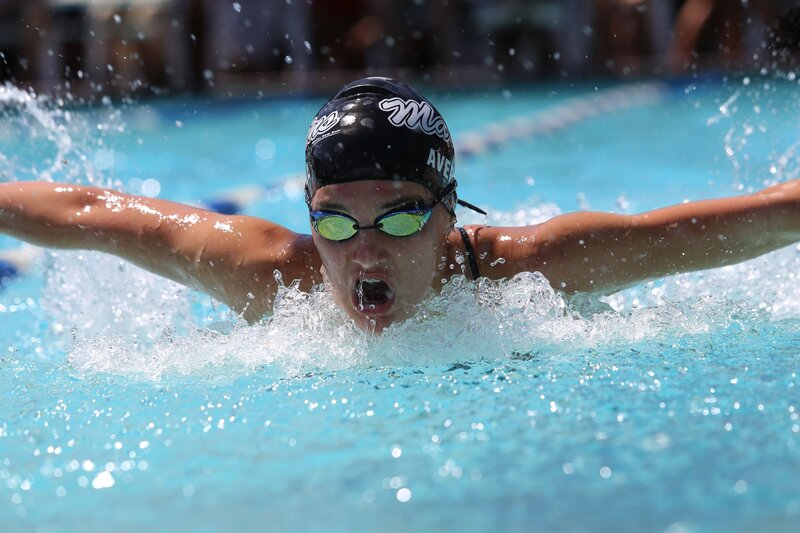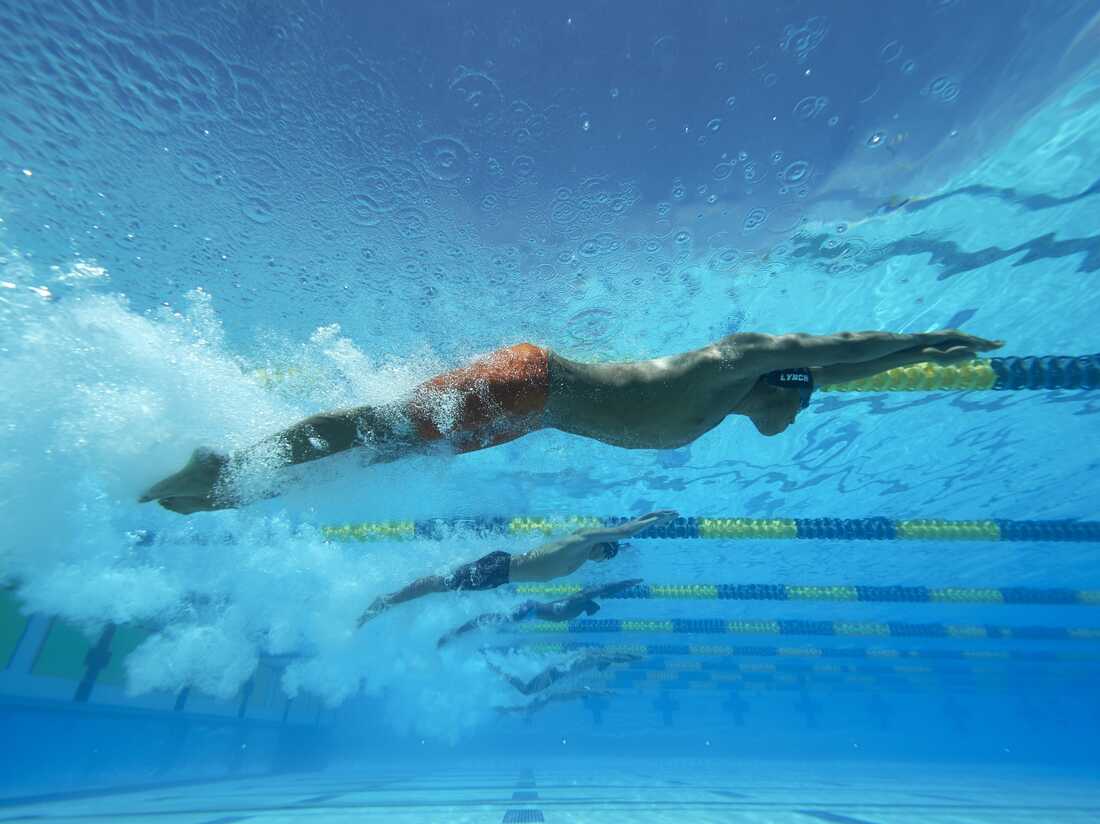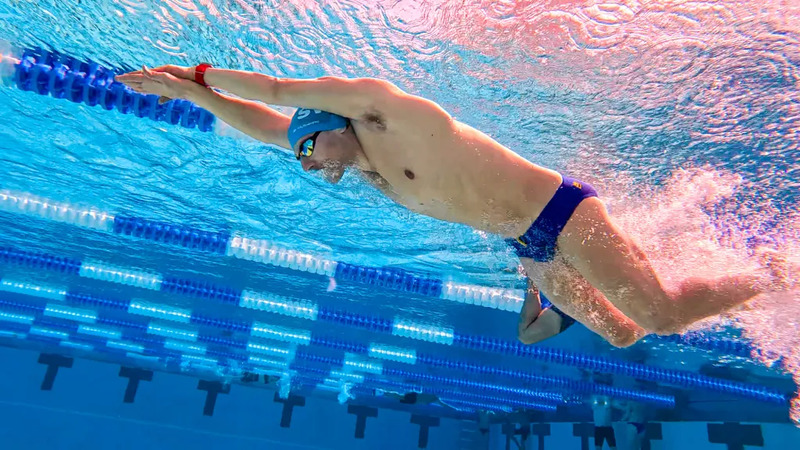The butterfly stroke, also known as the fly swimming technique, is a captivating display of power in the pool. However, mastering this demanding swimming style requires a refined butterfly swimming technique. Here at Swim Time Log, we want to make sure you’re getting the most out of your swimming experience. To help you improve your butterfly swim technique and swim faster, smoother, and more efficiently, we’ve broken it down into five distinct categories.
1. Catch Your Breath in the Right Spot: Breathe Easy While Maintaining Momentum
Breathing in the butterfly stroke can be tricky. Taking a breath too early disrupts your body position and momentum while waiting too long can leave you gasping for air. Here’s how to find the sweet spot for breathing:
- Time your breath to the late pull phase: Aim to breathe during the butterfly stroke technique’s late pull phase when your arms are almost recovered above the water. This maximizes power from the pull before turning your head for a breath.
- Quick and efficient: Make your breath a quick and efficient in-and-out action. Avoid lifting your head excessively, which can disrupt your body position.
- Exhale underwater: Remember to exhale completely underwater before turning your head to breathe. This prevents water from entering your mouth and minimizes the need for a large head lift.

Catch Your Breath in the Right Spot
2. Use Your Hips: The Engine of Your Butterfly Stroke
Strong hips are the driving force behind a powerful butterfly stroke. Here’s why engaging your hips is crucial:
- Initiate the powerful undulation: Your hips initiate the wave-like body movement characteristic of the butterfly stroke. Think of your hips as the engine propelling you forward.
- Coordinate kick with arm stroke: Engage your hips to synchronize the powerful dolphin kick with your arm pull, creating a rhythmic and efficient propulsion system.
- Maintain a flat body position: A strong core and engaged hips work together to maintain a flat body position, minimizing drag in the water.
Butterfly stroke drills that focus on isolated hip movements can help improve your hip engagement and coordination. Consider incorporating drills like:
- Undulation drills: Practice the wave-like body movement with a kickboard or fins, focusing on initiating the movement from your hips rather than your shoulders.
- Single-arm butterfly drills: Swim with one arm at a time, focusing on hip rotation and body undulation to propel yourself forward.
3. Minimize Your Up-and-Down Motion: Streamline for Efficiency
While the butterfly stroke involves a natural undulation, excessive up-and-down movement can waste energy and slow you down. Here’s how to minimize your vertical movement:
- Focus on a flat body position: Maintaining a flat body position throughout the stroke cycle reduces drag and allows for smoother gliding through the water.
- Engage your core: A strong core helps keep your hips high and your body streamlined, preventing excessive bouncing up and down.
- Kick from your core: Initiate the dolphin kick from your core and hips, allowing the wave-like motion to travel down your legs rather than bending your knees excessively.

Use Your Hips
Butterfly stroke drills like flutter kick drills on your front or back can help you isolate your core and leg movements, promoting a more streamlined body position.
Click for information: 8 Butterfly Stroke Tips to Help You Improve Your Skill
4. Press Your Chest: Engage Your Upper Body for Power
The butterfly stroke requires a powerful butterfly stroke technique throughout the entire stroke cycle, not just during the pull phase. Here’s how to engage your upper body for maximum efficiency:
- Press your chest down during the glide: As you recover your arms, press your chest down slightly towards the water to maintain a streamlined position and prepare for the powerful downward pull.
- Engage your back muscles: Utilize your back muscles during the pull phase to create a powerful downward and backward sweep, propelling you forward.
- Maintain strong core engagement: A strong core connects your upper and lower body movements, allowing for efficient power transfer throughout the stroke cycle.
Butterfly stroke drills such as arm recovery drills with fins or paddles can help strengthen your upper body muscles and refine your pulling technique.
5. Time Your Kicks: A Continuous Source of Propulsion
Unlike the flutter kick used in freestyle, the butterfly stroke relies on a continuous dolphin kick for propulsion. Here’s how to ensure your kick is efficient and well-timed:
- Focus on a smooth up-and-down motion: Maintain a smooth and continuous up-and-down kicking motion with your legs together, engaging your core and hips for power.
- Coordinate with your arm stroke: The dolphin kick should be synchronized with your arm pull. Aim for a powerful kick as your arms recover above the water and a smaller, stabilizing kick during the pull phase.
- Maintain ankle flexibility: Point your toes and keep your ankles loose for efficient kicking.
Butterfly stroke drills that isolate your leg movements, such as flutter kick drills with a pull buoy or fins, can help refine your kicking technique and improve coordination with your arm stroke.

Time Your Kicks
By focusing on these five key areas of butterfly swim technique and incorporating butterfly stroke drills into your training regimen, you’ll be well on your way to refining your butterfly swim technique. Remember, consistent practice and seeking guidance from a qualified swim coach can further accelerate your progress.
Swim Time Log is your dedicated partner in your swimming journey. We offer a multitude of resources to support you, including:
- Video tutorials: Gain a deeper understanding of the butterfly stroke technique step by step with detailed breakdowns and video demonstrations.
- Sample butterfly stroke workouts: Explore a variety of training routines designed to target specific aspects of the butterfly stroke, helping you improve your technique, speed, and endurance.
- Online community forum: Connect with fellow swimmers, share experiences, and get expert advice from coaches and trainers on refining your butterfly swimming technique step by step.
Learn the butterfly stroke on our website and swim more efficiently, with more force than you ever imagined possible!
Read more: Discover Information About Butterfly Stroke: From History to Technique and Benefits
AUTHOR
Sang Nguyen
Sang Nguyen is a former national swimmer for Vietnam who has transitioned into coaching. With a passion for fostering a healthy swimming community and connecting like-minded individuals,......Read More
BLOG
Maybe You Are Interested
Butterfly Arm Stroke Movement
The butterfly stroke, with its captivating undulations and powerful movements, requires a refined butterfly arm...
2 Butterfly Kick Swimming Drills: Building Power from the Core
The butterfly stroke, known for its powerful undulations and graceful movements, relies heavily on a...
5 Ways to Improve Your Butterfly Swim Technique
The butterfly stroke, also known as the fly swimming technique, is a captivating display of...
8 Butterfly Stroke Tips to Help You Improve Your Skill
The butterfly stroke, also known as the butterfly swim, is undeniably one of the most...
Discover Information About Butterfly Stroke: From History to Technique and Benefits
The butterfly stroke, also known as butterfly swim or fly swim stroke, is one of...
Competitive Swimmer Diet in Olympics: Fueling Your Gold Medal Dreams
Competitive swimmers push their bodies to the limit, demanding a competitive swimmer diet that provides...